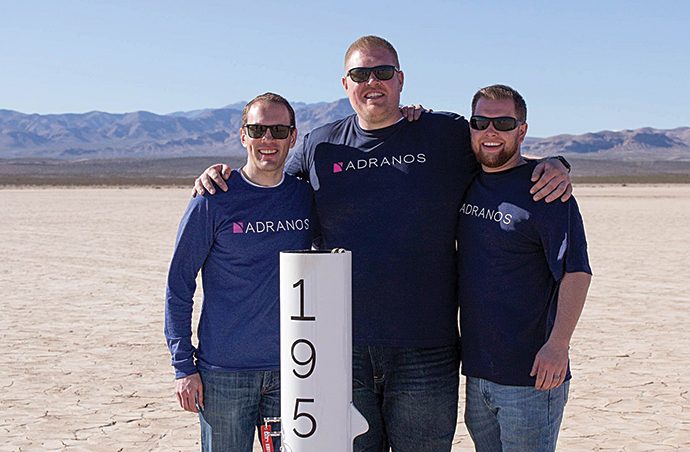When Purdue-affiliated Adranos Inc. recently closed a $1 million funding round, among the people shocked by the news was Chris Stoker, CEO of the rocket-science startup.
“We knew there was a lot of interest in our company but were shocked with both the speed and amount of the funding that was offered to us,” said Stoker, whose company won the grand prize at the U.S. Army’s inaugural xTechSearch competition. “We actually had to turn several interested investors away.”
That’s because this innovative startup in West Lafayette, Indiana, oversubscribed its target raise by $250,000 in less than one week after opening the round. Winning a prestigious Army entrepreneurship contest has a way of doing that.
Following Adranos’ successful launch of a prototype rocket and its corresponding grand prize award at the Army event, Stoker said the additional dollars were necessary to add key team members and scale up the firm’s manufacturing capabilities. The company is developing a novel high-performance, solid rocket fuel for long-range missile and space launch systems.
Adranos is but the latest successful startup to emerge from the Purdue Research Foundation Office of Technology Commercialization. Adranos joins a lengthy list of success stories owing their origins to Purdue’s renowned technology transfer. From Covert Defenses and Curasis to Evolve Biomechanics and Vestigo Aerospace, Purdue has quietly become the epicenter of Midwestern innovation.
Since 2013, some 223 startups affiliated with Purdue have launched. Collectively, they’ve raised $352 million in funding; and 210 are in active operation, 186 of which are based in Indiana. Major companies have acquired nine Purdue startups for $2.3 billion. Notable examples are Novartis AG acquiring Endocyte in 2018 for $2.1 billion and Plex Systems buying DATTUS Inc.
How did this happen so quickly in Indiana? After all, wasn’t this supposed to be the Rust Belt state that Chrysler forgot?
Well, a funny thing happened on the way to the national media’s favorite Midwest narrative. A new economy was born. Former Gov. Mitch Daniels (now Purdue University’s president) signed Right-to-Work into law in 2012, making Indiana the first Midwest state to pass such a bill; and he and subsequent administrations overhauled state government to make it more business friendly.

A series of record-setting years for economic development ensued. The American Legislative Exchange Council-Laffer Economic Outlook recently ranked Indiana as having the fifth-best economic outlook in the country. Eight years ago, Indiana ranked 22nd. And in January, the Consumer Technology Association’s 2020 U.S. Innovation Scorecard ranked Indiana No. 1 in the nation in tech job growth among small firms.
In 2019, the Indiana Economic Development Corp. secured 296 commitments from companies to locate or grow in the state. Together, these employers plan to invest more than $8.44 billion in their Indiana operations and create up to 27,137 new jobs with average wages of $28.60 an hour — marking all-time highs for both capital investment and average wages since IEDC was established 15 years ago.
Automotive manufacturing investments, life-science facility expansions and major logistics projects led the way, but the real story is the diversity of industries choosing Indiana as a go-to destination. From Arizona Isotopes locating in Miami County to Virginia-based LifeNet Health going to Hendricks County, Indiana is attracting global firms to all corners of the state.
Longtime established players like Eli Lilly and Company, meanwhile, aren’t lagging. Lilly announced in November that it would invest $400 million in its manufacturing plant at its Lilly Technology Center campus in Indianapolis, creating 100 new highly skilled jobs. More recently, Fiat-Chrysler announced it would invest $400 million into a Kokomo engine plant. “We’ve set records for job commitments, average wages and capital investments in 2015, 2018 and 2019,” says Jim Staton, senior vice president and chief business development officer for IEDC. “We’re optimistic. We’ve had a really strong January. Our pipeline is full.”
Staton says marked improvement in talent and business climate facilitated gains in life sciences and manufacturing projects. “In life sciences, we had 43 projects last year,” he says. “That’s up 60% from 2018. We landed $958 million in capital investments and over 3,600 jobs in 2019; and in manufacturing, we secured 160 deals last year, accounting for $5.3 billion in investment and over 14,400 jobs that pay well above the average state wage. In technology, we landed 44 projects and 3,900 jobs at an average annual wage of $76,000.”
Staton says companies select Indiana for the “affordable lifestyle and employee loyalty. This is a steady and predictable place to do business. We were the only state in the Upper Midwest to increase in population the last several years. People are coming here to seek opportunities. We offer a business climate of low taxes, low costs and low business regulation. Our incentives application at the state is a page and a half and that covers all of our programs.”
Aaron Renn, an urban analyst who served as a senior fellow at the Manhattan Institute from 2015 to 2019, recently relocated himself and his family from New York City to Indianapolis, and he says the move has improved their quality of life. “I lived in New York for five years. I have better coffee and higher quality meats in Indy,” he says. “The bread is better. Things are cheaper here too — housing, taxes, etc. I’m getting reverse sticker shock.”
“A lot of good things are happening on the economic front. This is a thriving Midwest city that’s just waiting to be discovered.”

